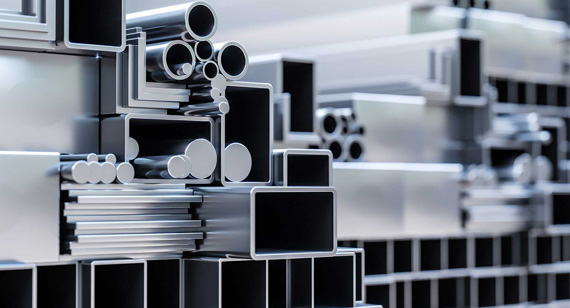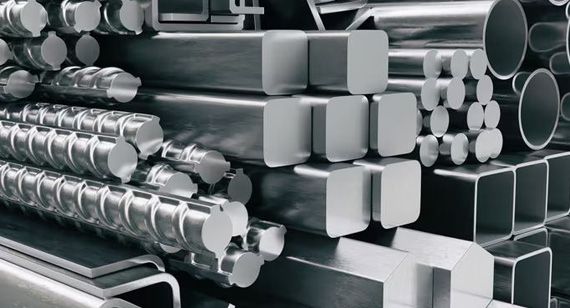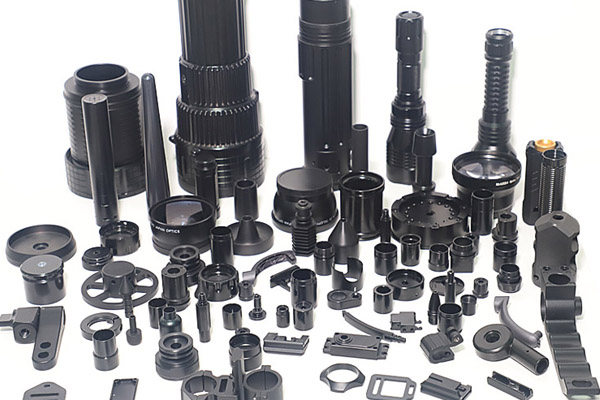15 years one-stop China custom CNC machining parts factory
 821 |
Published by VMT at Jul 02 2024
821 |
Published by VMT at Jul 02 2024
Aluminum vs Stainless Steel: A Comparison
Introduction
In the field of CNC machined parts manufacturing, aluminum and stainless steel are two common metal materials, each with unique characteristics and broad application scenarios. This article aims to comprehensively compare aluminum and stainless steel in terms of elemental composition, physical properties, machinability, and applications, helping readers make more reasonable and scientific decisions when choosing materials.
Aluminum and Stainless Steel: An Overview
What is Aluminum?
Aluminum is a lightweight, silvery-white metallic element with the chemical symbol Al and atomic number 13. Aluminum boasts excellent electrical and thermal conductivity, good machinability, and strong corrosion resistance, making it one of the most widely used non-ferrous metals in the industry. Aluminum alloys are formed by adding other alloying elements (such as copper, magnesium, zinc, etc.) to aluminum, enhancing its strength, hardness, and corrosion resistance.

What is Stainless Steel?
Stainless steel is an iron-based alloy primarily composed of iron, chromium, and nickel. The chromium content must be at least 10.5%, which gives stainless steel its remarkable corrosion resistance. In addition to corrosion resistance, stainless steel has high strength, hardness, and wear resistance, making it an indispensable material in manufacturing.

Characteristics Comparison of Aluminum and Stainless Steel
Elemental Composition
Aluminum: Primarily composed of aluminum, with other alloying elements (such as copper, magnesium, zinc) added to form aluminum alloys, enhancing its mechanical properties and corrosion resistance.
Stainless Steel: Composed of iron, chromium, nickel, and other elements. Chromium addition is key to its corrosion resistance. Stainless steel may also contain molybdenum, manganese, and other elements to further enhance its properties.
Electrical and Thermal Conductivity
Electrical Conductivity: Aluminum is an excellent electrical conductor, with conductivity far surpassing that of stainless steel. This makes aluminum widely used in electrical transmission and electronic devices.
Thermal Conductivity: Aluminum also has superior thermal conductivity, allowing it to rapidly conduct heat. Hence, aluminum is often used in heat sinks and heat exchangers. In contrast, stainless steel has poorer thermal conductivity, making it suitable for environments requiring high-temperature corrosion resistance.
Weight
Aluminum: With a density of approximately 2.7g/cm³, aluminum is representative of lightweight metals. This gives aluminum products a significant weight advantage, ideal for applications needing weight reduction.
Stainless Steel: Typically has a density between 7.9-8.0g/cm³, making it much heavier than aluminum. Therefore, stainless steel might not be the best choice for weight-sensitive applications.
Corrosion Resistance
Aluminum: Although aluminum has certain oxidation and corrosion resistance, it is relatively poor. In extreme acidic or alkaline environments, aluminum can corrode quickly. However, surface treatments (such as anodizing, coating) can significantly enhance aluminum's corrosion resistance.
Stainless Steel: With sufficient chromium content, stainless steel can form a dense passivation layer, providing excellent corrosion resistance. Stainless steel remains stable in various chemical media, making it ideal for products requiring high corrosion resistance, such as cookware and medical instruments.
Hardness
Aluminum: While aluminum has high strength, its hardness is relatively low. Aluminum products can easily deform under external forces, making them suitable for applications with low shape stability requirements.
Stainless Steel: With high hardness and strength, stainless steel can withstand greater pressure and impact. Stainless steel products maintain stable shape and performance in harsh environments.
Durability
Aluminum: Aluminum's durability is limited by its corrosion resistance and hardness. In highly corrosive environments or under substantial external forces, aluminum products' durability may be compromised.
Stainless Steel: Stainless steel’s excellent corrosion resistance and high strength provide outstanding durability. Stainless steel products can maintain good performance even in harsh environments.
Tensile Yield Strength
Aluminum: Aluminum alloys have high tensile yield strength, meeting many structural components' strength requirements. However, compared to stainless steel, its strength is still inferior.
Stainless Steel: Stainless steel’s tensile yield strength exceeds aluminum, making it the preferred material for high-strength structural components. Stainless steel can withstand greater tensile forces without yielding or breaking.
Cost
Aluminum: Although aluminum's raw material price is relatively low, its overall cost may not be cheap due to higher processing and production costs (such as surface treatment, forming).
Stainless Steel: Stainless steel's raw material price and processing cost are higher, resulting in relatively high product prices. However, in applications requiring high strength and corrosion resistance, stainless steel's cost-effectiveness remains high.
Machinability
Aluminum: Aluminum’s physical properties make it easy to cut, drill, and form. Aluminum products' processing is relatively simple and cost-effective. However, aluminum's softness can lead to deformation during processing.
Stainless Steel: With higher hardness, stainless steel is more challenging to process. Nevertheless, stainless steel has good plasticity and weldability, suitable for various processing and forming methods.
Applications of Aluminum and Stainless Steel
Aluminum Applications
Due to its light weight, high strength, and good machinability, aluminum finds wide applications in various fields. In CNC machining parts manufacturing, aluminum CNC machined parts are widely used in aerospace, automotive manufacturing, electronic devices, construction, and home decoration.
Aerospace: Aluminum and its alloys are the primary structural materials for aircraft and spacecraft due to their lightweight and high strength, used in manufacturing fuselages, wings, landing gear, and other components.
Automotive Manufacturing: Aluminum parts play a crucial role in automotive manufacturing, such as engine blocks, wheels, and body frames, helping reduce vehicle weight and improve fuel efficiency.
Electronic Devices: Aluminum’s conductivity and aesthetics make it ideal for electronic device housings and heat sinks, such as laptops, smartphones, and tablets.
Construction and Home Decoration: Aluminum doors, windows, curtain walls, and pipes are widely used in construction due to their corrosion resistance, ease of processing, and aesthetics.

Stainless Steel Applications
With its excellent corrosion resistance, high strength, and good machinability, stainless steel occupies an important position in manufacturing. Stainless steel CNC machined parts are widely used in food processing, medical instruments, chemical equipment, marine engineering, and more.
Food Processing: Stainless steel is non-toxic, odorless, and corrosion-resistant, making it the preferred material for food processing equipment, such as mixers, fermentation tanks, and storage tanks.
Medical Instruments: Stainless steel is extensively used in medical instrument manufacturing, such as surgical instruments, implants, and medical devices, ensuring safety and effectiveness with its corrosion resistance and biocompatibility.
Chemical Equipment: Stainless steel can resist various chemical media's corrosion, making it ideal for chemical equipment like reactors, storage tanks, and pipelines.
Marine Engineering: Stainless steel can withstand seawater corrosion and marine biofouling, making it the preferred material for marine platforms, ships, and subsea pipelines.

Aluminum vs Stainless Steel: Advantages and Disadvantages of Each Metal
Advantages of Aluminum
Lightweight: Aluminum's low density results in lighter parts, beneficial for reducing overall structure weight.
Excellent Thermal Conductivity: Aluminum is a superb thermal conductor, suitable for heat dissipation applications.
Good Machinability: Aluminum is easy to cut, drill, and form, with relatively low processing costs.
Aesthetics: Aluminum products have smooth surfaces, easy to surface treat, such as anodizing, enhancing their appearance.
Advantages of Stainless Steel
Superior Corrosion Resistance: Stainless steel can resist various chemical media's corrosion, maintaining long-term stability.
High Strength: Stainless steel has high strength and hardness, capable of withstanding significant pressure and impact.
Good Machinability: Despite higher processing difficulty, stainless steel has good plasticity and weldability, suitable for various processing methods.
Sanitation: Stainless steel is non-toxic, odorless, and antibacterial, suitable for food, medical, and other high hygiene standard fields.
Disadvantages of Aluminum
Limited Corrosion Resistance: In extreme environments, aluminum's corrosion resistance is inferior to stainless steel.
Lower Hardness: Aluminum's hardness is relatively low, easily deforming under external forces.
Easily Scratched: Aluminum products' surfaces can be easily scratched, affecting aesthetics.
Disadvantages of Stainless Steel
Higher Cost: Stainless steel’s raw material and processing costs are higher than aluminum.
Heavier Weight: Stainless steel's density results in heavier parts.
Poorer Thermal Conductivity: Stainless steel's thermal conductivity is inferior to aluminum, unsuitable for high-efficiency heat dissipation applications.
VMT CNC Machining Manufacturing Capabilities
VMT leverages advanced CNC machining technology to efficiently and precisely produce aluminum and stainless steel CNC machined parts. Whether aluminum or stainless steel parts, VMT offers customized CNC machining services to meet diverse customer needs. With precise CNC programming and advanced machining equipment, VMT ensures parts' dimensional accuracy, surface quality, and machining efficiency, providing high-quality CNC machined parts to customers.

Aluminum vs Stainless Steel: Which Metal Should You Use?
When choosing between aluminum and stainless steel, it is crucial to consider factors such as cost, application, machinability, machining waste, and aesthetic requirements.
Cost
Cost is an important consideration when choosing materials. Stainless steel's raw material and processing costs are usually higher than aluminum, but in applications requiring high strength and corrosion resistance, stainless steel's cost-effectiveness may be higher.
Application
Choosing materials based on the application scenario is crucial. Aluminum is suitable for lightweight, heat dissipation applications, while stainless steel is more suitable for high-strength and corrosion-resistant applications.
Machinability
Aluminum's machinability is better than stainless steel, with lower processing costs. However, in certain complex shapes and structures, stainless steel's better plasticity and weldability may be advantageous.
Machining Waste
When considering machining waste, aluminum's machining waste may be more manageable, while stainless steel's machining waste can be more difficult to handle and requires more processing costs.
Aesthetic Requirements
Both aluminum and stainless steel can be surface treated to enhance aesthetics. However, aluminum's ease of processing and surface treatment may make it more suitable for certain high aesthetic requirement products.
In conclusion, choosing aluminum or stainless steel should be based on the specific application scenario, cost, machinability, machining waste, and aesthetic requirements. VMT's advanced CNC machining technology can efficiently and precisely produce aluminum and stainless steel CNC machined parts, providing high-quality CNC machining services to customers.
Frequently Asked Questions – Aluminum vs Stainless Steel
Which Metal Should I Choose, Aluminum or Stainless Steel?
Choosing between aluminum and stainless steel should be based on specific application needs, performance requirements, budget, and sustainability. Here are some guidelines:
Weight Considerations: If the weight of the product is a crucial factor, aluminum is usually the better choice due to its lightweight properties. It can help reduce the overall structure weight and improve energy efficiency, especially in aerospace and automotive manufacturing.
Corrosion Resistance: If the product will be exposed to corrosive environments, such as chemical processing, food processing, or marine environments, stainless steel is preferred due to its superior corrosion resistance. Stainless steel can maintain its performance and appearance over a long period, reducing maintenance and replacement costs.
Strength and Hardness: For applications that need to withstand high pressure, impact, or wear, stainless steel has an advantage due to its high strength and hardness. It provides better structural integrity and durability.
Thermal Conductivity: If the product requires good heat dissipation, such as in electronic devices or automotive engine parts, aluminum is more suitable due to its excellent thermal conductivity.
Cost: Stainless steel is generally more expensive than aluminum, including raw material and processing costs. Therefore, aluminum may be a more economical choice if the budget is limited. However, in the long run, the durability and low maintenance cost of stainless steel may make it more cost-effective.
Aesthetic Requirements: Both aluminum and stainless steel can be surface-treated to enhance their aesthetics, but the natural metallic luster and texture of stainless steel may be more suitable for some high-end or public display applications.
How to Distinguish Between Aluminum and Stainless Steel?
Methods to distinguish aluminum from stainless steel include:
Appearance and Color: Stainless steel typically has a silvery-gray metallic sheen, while aluminum's color is lighter and more reflective. However, this is not a foolproof method since both can be surface-treated to alter their appearance.
Weight: Given that aluminum's density is much lower than stainless steel, a product of the same volume made from aluminum will be significantly lighter. Directly comparing the weights can provide an initial judgment.
Magnetic Test: Most stainless steels (especially ferritic and martensitic stainless steels) are magnetic, while pure aluminum is non-magnetic. Using a magnet can quickly differentiate between the two. However, some aluminum alloys may contain magnetic elements (such as iron), so this method is not entirely accurate.
Chemical Test: In laboratory conditions, chemical reagents can provide more accurate differentiation. For example, silver nitrate solution can detect chromium in stainless steel, whereas aluminum does not show a significant reaction.
Which is More Durable, Aluminum or Stainless Steel?
Durability depends on the specific application environment and requirements. In corrosive environments, stainless steel is more durable due to its superior corrosion resistance. In applications where weight reduction is essential, aluminum’s lightweight property can make it more durable by reducing structural burden and wear. Additionally, the high strength and hardness of stainless steel make it more durable in high-stress applications. Therefore, it is necessary to evaluate the specific conditions to determine which material is more durable.
Conclusion
Aluminum and stainless steel are important materials in CNC machined parts manufacturing, each with unique advantages and applications. When choosing, it is essential to consider factors such as cost, application needs, performance requirements, machinability, and aesthetic requirements. By selecting the right material, you can optimize product design, improve production efficiency, and reduce costs. With the continuous development of CNC machining technology, the application fields of aluminum and stainless steel will continue to expand, bringing more innovation and opportunities to the manufacturing industry.
